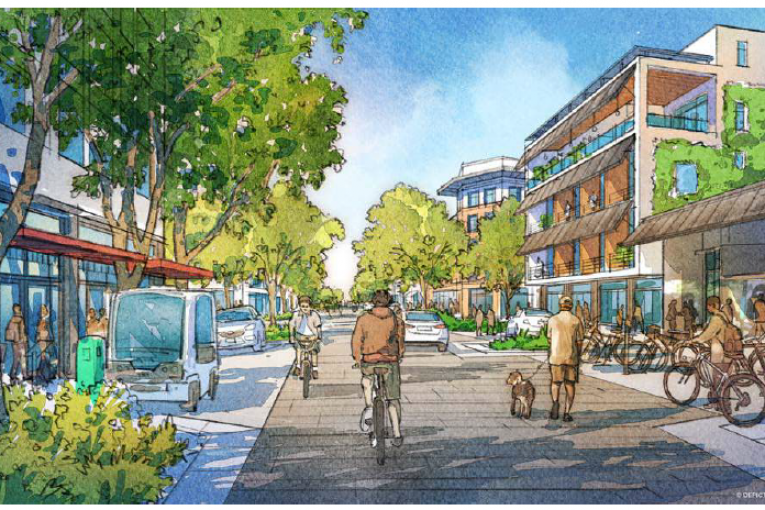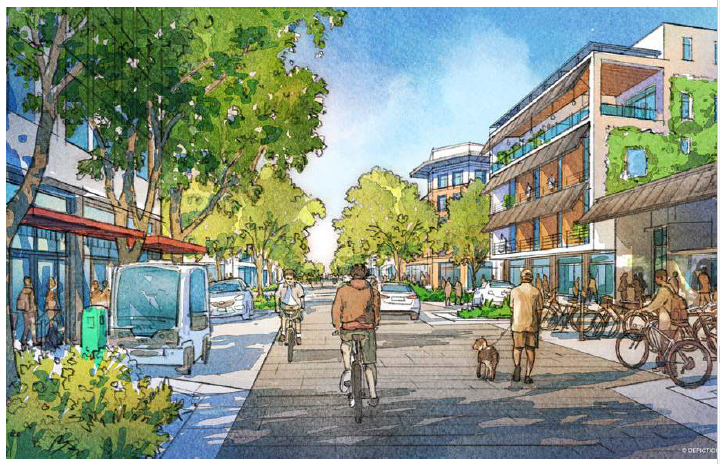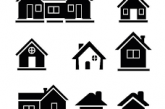

By Zohd Khan
DAVIS — During a public hearing held at the Dec. 1 city council meeting, Assistant City Manager Ashley Feeney encouraged the council to renew the Downtown Business Improvement District (DBID) budget and collect a DBID assessment for the 2021-2022 fiscal year.
Feeney explained that the DBID proceeds are used for “both the downtown and for other activities that benefit district businesses.”
Each year, the city also authorizes the Davis Downtown Business Association (DDBA) to prioritize and administer the use of the DBID assessments. The continuation of this process into the upcoming year (2021-2022) was another recommendation made by Feeney Tuesday night.
Feeney explained that the DDBA has “really stepped up in helping to support their members, the downtown businesses that have been impacted by this ongoing pandemic.”
Feeney also reported that as of Tuesday’s meeting, the city had not received any letters protesting renewal of the DBID budget plan, which signifies a general acceptance of the plan thus far.
Such an acceptance was evident amongst the councilmembers, who expressed great acclaim for the DDBA’s recent efforts in aiding businesses in downtown Davis.
Councilmember Dan Carson stated “the progress DDBA has made in the last year, in its organization and efforts, is astonishing” and that “the work they put in to Open Davis” was very helpful. Carson cited the Healthy Davis Together Initiative and the Gifting Stimulus or “Gift Card” program as specific instances of the DDBA’s helpfulness recently.
Along with Carson, other councilmembers commended Brett Maresca, Executive Director of the DDBA, for his leadership during a time “where everyone is hurting” from the COVID-19 pandemic.
One public comment from Alan Hirsch, who advocated for the implementation of more trees into Downtown Davis, offered various reasons to support his proposal, including the need to provide shade as the Davis temperatures continue to increase as a result of climate change.
In addition, he argued that adding more trees Downtown would encourage increased pedestrian window shopping/lingering, which would mean more activity and energy for businesses in Davis’ downtown. This concept would also apply to parking, as locals would be more inclined to park in shaded areas.
Hirsch further explained that for executing this tree integration project, the city could use the 80 treeholes that he encountered while he was exploring downtown.
While planting these trees, Hirsch emphasized the need to plant them properly, and “to improve soil conditions so that they will grow faster.”
At the meeting, his slide presentation also revealed examples of streets Downtown where trees could be planted. He addressed the issues with Davis’ current trees, stating that they are “smaller trees, and they are hiding the buildings while not letting enough shade get in.”
Since Hirsch believed smaller trees hinder commerce due to the aforementioned issues, he believes that this plan would be beneficial in helping businesses throughout Davis.
Councilmember Will Arnold expressed optimism in Hirsch’s propositions. Arnold shared that earlier, he had the opportunity to meet with Hirsch, who showed Arnold the various things he discussed in the presentation. Arnold stated that he is “encouraged by a recent grant that we have received, and there may be an opportunity to do what was described [in the presentation].”
Arnold further acknowledged that tree planting season is during the earlier months of the year, so we are approaching the perfect opportunity to carry out Hirsch’s plan.




Please, plant some lady trees. Males leave all that pollen floating in the air.
Wouldn’t be a bad idea to review the Ogren Plant Allergy Scale for downtown trees. I’ll pass the suggestion along.
My wife appreciates it. She is allergic to almost all tree and plant pollen.
trees today may choose their own sex, regardless of their reproductive characteristics, and decisions about planting a tree due its characteristics should be private and made only between the planter and their arborist.
Actually many trees/plants are natually ‘transgender’/bisexual…
Do Plants Have Sexes? | Britannica
As we drift further off-topic…
Most have ‘perfect’ flowers, meaning all parts in the same flower. Some have separate male and female flowers on the same tree. Some have separate male and female flowers on separate trees. Of those, the male trees often are wind-pollinated, which means they have tiny pollen that is readily wind-borne. Those tend to be some of the worst allergy trees due to their heavy pollen load and its wide distribution.
Cities like to plant the male varieties because they don’t have fruit or seed litter. In the case of some, like ginkgo, that’s crucial: the female fruit is usually described as smelling like dog vomit. Fortunately, ginkgo pollen is heavy and tends to fall right under the tree, and it’s not a major allergy species. Chinese pistache, likewise, has heavy pollen, and the male trees are preferred for the lack of fruit litter — and the male cultivar has especially nice fall color. But in other instances the choice could be made to use a female variety, or to use some care to select less allergenic species entirely. Unfortunately, that rules out oaks, including our native Valley oak. In point of fact, we have very few native tree species that are appropriate for downtown or urban forestry in higher-density areas. So the city and Tree Davis tend to plant those in the larger open areas. The new plantings Tree Davis did along Russell to replace the declining Black walnuts there are native and non-native oaks.
And, males leave a lot of “pollen” elsewhere… some females swell up when exposed to it…
Just going with the “drift”…
On topic… where would one put more large canopy trees downtown? And at what cost(s)?
Usual rule of thumb is canopy = root structure, as to extent (there are exceptions)…
Tree roots are major causes of sidewalk, curb and gutter uplift (creating tripping/accessibility issues)… some species this is more dramatic than others… curb and gutter uplift can often lead to more water getting into the subgrade of a street, leading to significant road deterioration…
Be careful what you ask for… you might get it…
Don S could either confirm or rebut…
Choosing trees for urban situations requires expertise. The list is not long, but there are good options. Root structure just becomes one of the most important criteria, along with low litter and tolerance for adverse conditions. This is why Tree Davis has a technical advisory committee.
I believe the area around 2nd and G Streets had a lot of mature trees that were taken out a few years ago, leaving the area looking rather barren ever since. Does someone remember what the reason was?
There used to be several mature elms in downtown Davis. That may be what you were thinking of. Disease and the elm leaf beetle necessitated removal. Calleryana pears are being removed all over the place due to poor branch structure. Modesto ash are gradually being removed from east Davis due to disease and branch structure issues. Chinese hackberries have been dying in Willowbank and on some of the numbered streets downtown from an unidentified disease that looks and functions like verticillium wilt; plus they started getting a species-specific aphid a few years ago that has become quite a nuisance.
The history of urban forestry is largely learning from the last generation’s mistakes.
Thanks for the info! I believe the elm disease removal is what I was thinking of.
If that “species specific aphid” is the thing that produces the nuisance sticky stuff, I’ve got that in my hackberry. Not my favorite tree.
Asian woolly hackberry aphid came into the area in 2002. It only attacks the Chinese hackberry, not even attacking other species in the same genus, but unfortunately Chinese hackberry was the most widely planted type in our region. The sticky stuff is the sugary excretion from the aphids. It is water soluble, sort of, but an infested tree generates a lot of this sort of maple syrup-like film over everything in the tree canopy shadow. Which also attracts ants. At this point, the biggest threat to Chinese hackberries comes from the people who live beneath them.
Imidacloprid drench is used to manage the aphids. While that pesticide is a concern for harm to pollinators, the hackberry is wind-pollinated and so the species is little visited by bees, if at all.
Needless to say, nobody is planting or selling Chinese hackberries any more.
True story, as I’ve learned from many others… applies to more than urban forestry… it’s called “life”, I’ve heard… gets to a famous song refrain… “… when will they ever learn”… a process, not a fait accompli…
As I walk around my neighborhood where the urban forest is in the 50 to 70 year old range I have three observations to add.
First, the cork oaks seem to be doing well and are producing plenty of acorns. Seems it wouldn’t be hard to propagate more of them for planting around town.
Second, the female gingko trees produce fruits that smell bad and stick to your shoes. I remember being told this back in my college botany days but never experienced it until recently. The male gingko trees are, in my opinion, better for landscaping.
Finally, Most of Davis is built on class I soils and is excellent for growing fruit trees. People should plant more fruit trees in private yards. Citrus and members of the genus Prunus that includes plums, peaches, cherries and apricots seem to do well here, especially the plums.
I made four points with my presentation:
1. you need shade in downtown more as temperature go up with climate change
2. There are opportunity to plant as much as 80 new trees in Downtown Davis
3. We have favored short trees in recent planting in Downtown. They hide merchants signs, banner and street lights. and block passage buses and trucks if they overhang the street to provide shade.
4. If you contrast trees in Downtown Davis vs those in good tree ciies, i.e. Midtown & Downtown Sac Paris & NY City You can see how tall trees…that are pruned high… make a much nicer shopping/urban environment.
WATCH THE PRESENTATION VIDEO on Tree in our downtown here:
If you wish to see a highly abbreviated 2 minute version of this presentation I made before city council on Downtown Davis Tree Opportunities, you can go to that meetings video (12-1-20) on city website. and move to slider time to item 6 public comment, time stamp 2:07:01. You can jump to video directly at https://davis.granicus.com/player/clip/1217?view_id=6&redirect=true